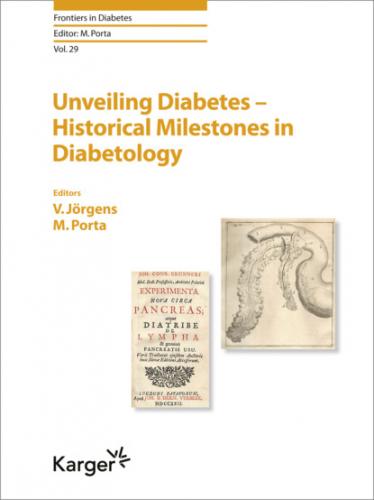Gale, E. (Bristol)
Dr. R.D. Lawrence: His Contribution to Diabetology
Lawrence, J. (London)
Diabetes Control Can Avoid Complications: The Pioneering Work of Jean Pirart
Lefèbvre, P.J. (Liège)
Together We Are Stronger: The ADA and EASD
Grüsser, M.; Jörgens, V. (Düsseldorf )
The Discovery of Glucagon and Glucagon-Related Peptides
Lefèbvre, P.J. (Liège)
History of the Treatment of Diabetic Ketoacidosis
Alberti, K.G.M.M. (London)
Milestones in the History of the Metabolic Management of Hyperglycemia in Pregnancy
de Leiva-Pérez, A.; Brugués, E. (Barcelona); de Leiva-Hidalgo, A. (Barcelona/Valencia)
Saving Sight: A History of Diabetic Eye Disease
Porta, M. (Turin); Klein, R.; Klein, B.E.K. (Madison, WI); Kohner, E.M. (London)
The History of Prevention and Treatment of Diabetic Nephropathy
Parving, H.-H. (Copenhagen); Rossing, P. (Copenhagen/Gentofte)
A History of Patient Education for People with Diabetes: A Very Personal View
Jörgens, V. (Düsseldorf )
Psycho-Social Issues in Diabetes: A Posthumous Contribution by Bruno Bruni and Pierluigi Barbero
Gamba, S.; Porta, M. (Turin)
How Technology Improved Care: Troves of the Diabetes Museum in Turin
Gamba, S.; Porta, M. (Turin)
Three and a Half Thousand Years of Diabetes Research
Porta, M. (Turin); Jörgens, V. (Düsseldorf )
Jörgens V, Porta M (eds): Unveiling Diabetes - Historical Milestones in Diabetology. Front Diabetes. Basel, Karger, 2020, vol 29, pp VII–VII (DOI: 10.1159/000506564)
This book is not written by professional historians and it does not pretend to cover all aspects of the subject. We asked friends and colleagues to contribute a chapter – several of them are Honorary Members of the European Association for the Study of Diabetes. Some of the authors personally contributed important discoveries which represent milestones in the history of diabetes research. We are particularly proud to include a chapter authored by a Lady of the British Empire who made major contributions to the prevention of blindness in diabetic eye disease, and of a diabetologist who was knighted for his work for people with diabetes. We thank heartfully all authors for their time and effort and the team at Karger Publishers for their continuous support.
We hope you will enjoy reading this book and that you will find useful information about previously neglected or unknown aspects of the history of diabetes research. We hope as well that the book may contribute to the correction of some myths in the history of diabetes research.
The history of diabetes research is not only the story of great discoveries, it is also the story of mistakes, missed opportunities, and authorities that obstructed progress. An example is the determination of HbA1c – it took almost 2 decades from its discovery in Teheran until clinical diabetologists introduced it into clinical medicine. Another example is patient education aiming at self-treatment. It was underestimated for half a century – for decades opinion leaders in diabetology strictly opposed the idea that people can be trained to adjust their insulin dosage themselves based upon the results of self-monitoring.
The most important advances in diabetes research to date have been the discovery of pancreatic diabetes by Oskar Minkowski and Josef von Mering in 1889 and – even more important for people with diabetes – the first successful clinical use of life-saving insulin in Toronto in 1922. Many diabetologists worldwide will be obliged to give speeches and write articles about the history of diabetes research to celebrate the 100th anniversary of the discovery of insulin in 2022. We hope that they will find inspiration in this book.
Viktor Jörgens, Düsseldorf, Germany
Massimo Porta, Turin, Italy
Jörgens V, Porta M (eds): Unveiling Diabetes - Historical Milestones in Diabetology. Front Diabetes. Basel, Karger, 2020, vol 29, pp 1–13 (DOI: 10.1159/000506554)
______________________
Diabetes in Ancient Times: The Long and Winding Road to Insulin
Massimo Porta
Department of Medical Sciences, University of Turin, Turin, Italy
______________________
Abstract
The onset of disproportionate urination has been known since the mists of time, as was the notion that urine emitted in large quantity was often sweet and had the property of attracting bees, flies and other arthropods, or even vertebrates. Mention of diabetes is made in ancient medical textbooks from China, India, and Egypt. In Roman times, Aulus Cornelius Celsus and Rufus of Ephesus commented on polyuria, polydipsia, and weight loss, while Aretaeus of Cappadocia gave the first full clinical and empathic account of the signs, symptoms, and deep discomfort experienced by patients. Islamic medicine brought few contributions to diabetology, as did the Schola Medica Salernitana in the Middle Ages. In 1676, Thomas Willis was the first to establish a distinction between diabetes “mellitus,” where the urine is as sweet as honey, and the other forms of polyuria, and Matthew Dobson demonstrated in 1776 that the sweet taste was due to the presence of sugars capable of fermentation. This led John Rollo, Surgeon-General of the Royal Artillery, to strictly limit carbohydrates in his “rancid” diet. Finally, in 1815, the French chemist Michel-Eugène Chevreul identified the sugar as glucose, opening the way to its quantitation for diagnostic and therapeutic purposes. In 1806, the Englishman Willian Hyde Wollaston showed the presence of sugar in the blood, and in 1855 Claude Bernard theorized that diabetes was the result of overproduction of glucose by the liver. Also in France, Apollinaire Bouchardat suggested the suppression of bread and almost all other carbohydrates from the diet but conceded their partial reintroduction after the disappearance of glycosuria, which the patients could detect by tasting their own urine, a first in self-management! Finally, in 1889, von Mering and Minkowski
